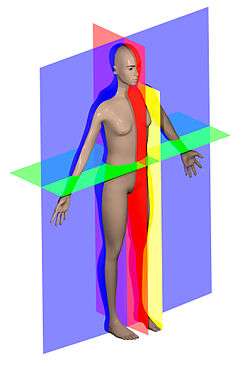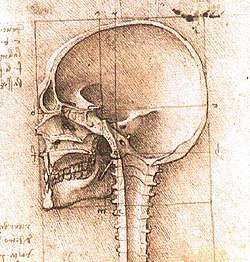Sagittal plane
| Sagittal plane | |
|---|---|
 The main anatomical planes of the human body, including mid-sagittal or median (red), parasagittal (yellow), frontal or coronal plane (blue) and transverse or axial plane (green) | |
 Mid-sagittal section of a human skull, by Leonardo da Vinci, c. 1489 | |
| Details | |
| Identifiers | |
| Latin | plana sagittalia |
| TA | A01.2.00.003 |
| FMA | 71926 |
| Anatomical terminology | |
A sagittal plane (/ˈsædʒɪtəl/), or longitudinal plane, is an anatomical plane which divides the body into right and left parts.[1] The plane may be in the center of the body and split it into two halves (mid-sagittal) or away from the midline and split it into unequal parts (para-sagittal).
Most elements of Irish dancing occur in the sagittal plane.[2]
Variations in terminology
Examples include:
- The terms median plane or mid-sagittal plane are sometimes used to describe the sagittal plane running through the midline. This plane cuts the body into halves (assuming bilateral symmetry),[3] passing through midline structures such as the navel and spine. It is one of the planes which, combined with the Umbilical plane, defines the four quadrants of the human abdomen.[4]
- The term parasagittal is used to describe any plane parallel to the sagittal plane. In practice, such a section is often referred to simply as a "sagittal" view because viewing is achieved along the sagittal axis (see below). Owing to the specific nature of its definition, only one true sagittal plane exists, and it corresponds to the "mid-sagittal" view. Be aware that the term "sagittal view" may be applied to any parasagittal section as well as the sagittal plane, as the parasagittal and sagittal axes are identical (parallel to the sagittal plane).
Specific named parasagittal planes include:- The midclavicular line crosses through the clavicle.
- Other sagittal lines/planes include the lateral sternal and parasternal.[5]
The term sagittal is derived from the Latin word sagitta, meaning "arrow". An image of an arrow piercing a body and passing from front (anterior) to back (posterior) on a parabolic trajectory would be one way to demonstrate the derivation of the term. Another explanation would be the notching of the sagittal suture posteriorly by the lambdoidal suture —similar to feathers on an arrow.
- Sagittal axis or anterior-posterior axis is the axis perpendicular to the coronal plane, i.e., the one formed by the intersection of the sagittal and the transversal planes
- Coronal axis, medial-lateral axis, or frontal axis is the axis perpendicular to the sagittal plane, i.e., the one formed by the intersection of the coronal and the transversal planes.[6]
- Extension and flexion are the movements of limbs within the sagittal plane.[7]
- Abduction and adduction are terms for movements of limbs within the coronal plane.[8]
Additional images
 Sectional planes of the brain
Sectional planes of the brain Identical twins at a gestational age of 15 weeks, shown in coronal and sagittal plane, respectively
Identical twins at a gestational age of 15 weeks, shown in coronal and sagittal plane, respectively.png) Brain anatomy (sagittal)
Brain anatomy (sagittal)
See also
References
- ↑ Mark Vella (May 2008). Anatomy for Strength and Fitness Training. New Holland Publishers. pp. 16–. ISBN 978-1-84773-153-1. Retrieved 4 January 2013.
- ↑ Madden, Christopher; Putukian, Margot; McCarty, Eric; and Young, Craig (2017). Netter's Sports Medicine, [unpaginated]. Elsevier Health Sciences. ISBN 9780323442572.
- ↑ "Median plane" at Dorland's Medical Dictionary
- ↑ Kapit, Wynn (2014). The anatomy coloring book. San Francisco: Pearson. ISBN 9780321832016.
- ↑ Yokochi, Chihiro; Rohen, Johannes W. Color Atlas of Anatomy: A Photographic Study of the Human Body. Hagerstown, MD: Lippincott Williams & Wilkins. pp. 2006. 217 p. ISBN 0-7817-9013-1.
- ↑ http://www.asu.edu/courses/kin335/documents/Movement%20Terminology.pdf
- ↑ Winslow, Valerie (Dec 23, 2008). Classic Human Anatomy: The Artist's Guide to Form, Function, and Movement. Watson-Guptill. pp. 32–33. ISBN 0823024156.
- ↑ Winslow, Valerie (Dec 23, 2008). Classic Human Anatomy: The Artist's Guide to Form, Function, and Movement. Watson-Guptill. pp. 34–35. ISBN 0823024156.